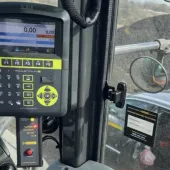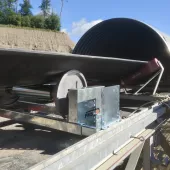Avoiding Weighty Issues

Drew Jones, technical support manager for Avery Weigh-Tronix, provides an insight into 10 common pitfalls associated with weighbridge installation, and offers some advice on how to avoid them.
A weighbridge is a major investment for any site. It is where you collect the information needed to charge your clients and meet legislative requirements. Before making such an important purchase, it pays to consider carefully where and how you plan to use the weighbridge. Involving your chosen supplier at an early stage in the specification process can help to ensure that you make the right decisions.
1. Determine what you need
Having decided to invest in a new weighbridge, take a good look at some of the physical aspects of your site and the types of weighbridge that are available. Weighbridges can be either surface mounted, with a short ramp leading up to the weighing surface and with the weighing equipment located underneath; or pit mounted, with the weighing equipment and platform located below ground so that the weighing surface is level with the road.
Access to a surface-mounted weighbridge requires the addition of on/off ramps, which, when added to the turning circle required for vehicles to access the bridge, means that above-ground weighbridges can take up a significant amount of space on site.
Conversely, pit-mounted weighbridges negate the need for ramps or guide rails and take up less surface area, although the civil and foundation work required can make them the more expensive option. Your chosen supplier will be able to advise on the best type of weighbridge for your site.
2. Undertake a site survey
It is important to obtain or make a plan of the area, highlighting the location of underground and/or overhead services. Underground services such as water, sewage, gas and electric, and related inspection holes, can affect where you locate the weighbridge. A pit-mounted weighbridge, for example, requires substantial foundation works for the construction of the pit itself, and the presence of underground services can add substantially to the cost. With a full site survey it is possible to identify and overcome such issues, either by ensuring that such services run underneath the weighbridge foundation or by moving the weighbridge location slightly.
Another key issue to consider for a pit-mounted weighbridge is the height of the water table and the level of the local surface-water drainage system, as this can lead to problems if the load-cells are left under water for long periods of time. While most load-cells have a good IP rating, leaving them submerged in water indefinitely can result in weighing errors and increased maintenance bills.
Whether pit or surface mounted, the installation of your chosen weighbridge, using a crane, can be complicated by the presence of overhead power lines. While it is possible to pay to have power lines switched off, a 33kV line is likely to retain some power, making extra care and forward planning essential. It may be worth consulting your supplier to find out whether ‘skating’ the weighbridge into position is a viable option.
3. Dispelling the myths: Planning permission
A common misconception is that planning permission is needed for such installations, but weighbridges are actually classed as mobile plant so no planning is needed. Moreover, a weighbridge office may not need permission either, if it is a portable building under 30m2.
4. Dispelling the myths: Weighing on an incline
Another common fallacy is that a level surface is needed in order to install a weighbridge. In fact, modern-day weighbridges can be designed to accurately weigh loads on an incline as long as the load-cells or weigh bars are installed vertically. The maximum incline will depend upon the type of weighbridge and its design. For example, the BMS from Avery Weigh-Tronix can weigh accurately at an incline of 5%.
5. Leave room to manoeuvre
There have been a number of occasions where weighbridges have been positioned so close to buildings that wing mirrors have been knocked off or vehicles have been simply unable to access the bridge. These may be extreme examples, but it pays to consider the turning circle of the longest vehicles likely to visit the weighbridge.
Although turning circle software is available from some architects, simply driving a longer lorry through cones where the weighbridge and ramps will be is a simple yet effective exercise. It is also worth arranging a site visit from your proposed supplier, who should be available to provide further advice.
One consequence of not having enough room for vehicles to enter a surface-mounted weighbridge properly is the installation of ramps that are too steep, thereby causing traction problems with slipping drive axles and even the grounding of anti-submarine bars on the backs of trailers.
6. Check the length required
It is also necessary to consider the length of the weighbridge; again, this will be dictated by the vehicles using it. In many instances bridges are far longer than is actually required. It is only necessary to consider the wheelbase, not the total length of the vehicle, as it is only the wheels that need to be on the weighbridge for weighing purposes.
7. Location, location, location: Health & Safety
Health and safety is of prime importance, particularly in the quarrying industry, with the HSE having highlighted accidents involving vehicles as an area of concern.
The weighbridge should not be positioned where there are likely to be any pedestrians. Vehicles stop on a weighbridge so that the operator can collect information, not just the weight but also data relating to the vehicle and possibly its contents. Generally, the driver will receive a ticket to prove that a transaction has taken place and it is important to try to ensure that he or she does not need to get out of the cab to sign or collect anything.
Also, weighbridges are often positioned near the entrance and/or exit to a site, so it is necessary to think about how to avoid causing traffic queues out on to the main highway. This may involve more than simply thinking about where to position the weighbridge.
Many sites position a wheel washer immediately in front of the weighbridge to remove any build-up of mud from the tyres. While this can be a good idea, care should be taken to ensure that the washer is not so close that the bridge is constantly wet and, therefore, more susceptible to rust. Moreover, when combined with grit and dirt, water from a wheel washer can effectively create a grinding paste and cause additional unnecessary wear on the deck surface.
8. Automation
Consider the benefits offered by a driver-operated docking station, entry and exit barriers, signage, traffic lights and even automatic number plate recognition (ANPR). These systems allow drivers to complete weighing transactions 24h a day, seven days a week, without having to leave their vehicles.
Unattended systems also provide more efficient processing of vehicles and allow the weighbridge to function without a dedicated operator, thereby reducing operating costs and extending the hours of availability.
9. Ensure your bridge is fit for purpose
If your weighbridge is located at a site entrance, consider any very heavy plant vehicles, such as cranes, that that may need access. Some of these vehicles may have an axle load that exceeds the weighbridge’s maximum axle load. Indeed, if it is a surface-mounted weighbridge, access maybe impossible. Check with your supplier to ensure that the weighbridge you select is fit for purpose.
10. Look after your investment
After investing time and capital in a weighbridge installation, investing in a service and maintenance contract will minimize downtime and ensure that it keeps working effectively over its long lifetime.
In conclusion, a weighbridge is a significant investment and one that is central to the success of your operation. Given some thought, and by taking professional advice, you can ensure that the weighbridge system operates smoothly over a long period of time. It is always best to seek professional assistance from your supplier, who should be willing to act in a consultative role both before and during the installation work, and then for the commissioning of the system.




